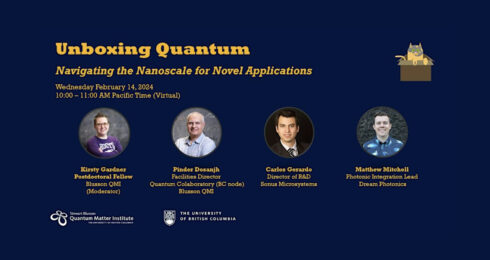Pictured: Ziliang Ye (right) in the lab with students. Image credit: Paul Joseph/UBC.
A photovoltaic (or solar) cell turns light from the sun into electricity. New research from the Stewart Blusson Quantum Matter Institute’s (SBQMI) Ziliang Ye and graduate student Dongyang Yang, and a team from University of Tokyo led by Yoshihiro Iwasa and Toshiya Ideue, has uncovered a new type of photovoltaic effect that occurs in specific configurations of certain Van der Waals, or two-dimensional (2D) materials. The team’s discovery, published today in Science, shows promise as a portable complement to conventional silicon-based solar energy-harvesting technology.
The effect Ye and colleagues describe is unusual, as the individual materials’ crystal symmetry does not allow for a bulk photovoltaic effect; together, however, a photovoltage emerges parallel to the interface due to the symmetry hybridization, making this novel 2D material combination, comprised of tungsten diselenide (WSe2) and black phosphorus (BP), more than the sum of its parts.
Van der Waals materials are comprised of layers that are weakly bonded to one another; this enables researchers to easily exfoliate a single layer of atoms using regular adhesive tape, the kind used in any home or office. 2D materials are of particular interest to Ye, Assistant Professor in UBC’s Department of Physics and Astronomy. These materials offer unique opportunities for engineering via a third spatial dimension; by stacking these atomically thin layers, new physics emerge.
The team chose WSe2 and BP for this experiment because of their unique symmetries, but the symmetry engineering proposed in this new work is applicable to a variety of Van der Waals materials. The paper establishes “symmetry engineering” as a concept, an important contribution to the field of 2D materials that will serve as a milestone in SBQMI’s 2D materials Grand Challenge, Engineering exotic phases in two dimensions.
The research partnership between Ye and UTokyo’s team fructified in late 2019 at a meeting of the Max Planck-UBC-UTokyo Centre for Quantum Materials (CQM) hosted at SBQMI. Ye first learned about Iwasa’s work at the 2018 CQM meeting, shortly after joining SBQMI as a new Principal Investigator.
“In the second year’s meeting, as soon as I learned about the discovery of this new photovoltaic effect, I took the initiative to characterize the spectrum of the responsivity,” said Ye. “Toshiya was in Vancouver for a week. During the day, we attended the CQM meeting, and at night, we were working on the experiment in the lab. It was a fun time.”
Inspired by their collaboration and its ongoing success, Ye and Iwasa are now working on a new device that takes advantage of their novel photovoltaic effect.
“This paper, for us, is a comma, not a period,” says Ye. “We will continue to work together to to explore other aspects of this phenomenon.”


